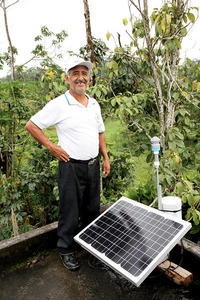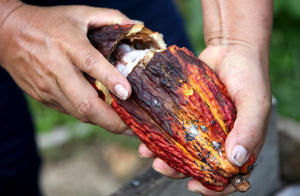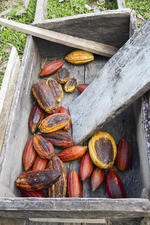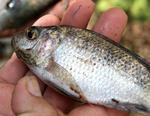T3- Environmental impacts of oil activities
Principal Investigators: Laurence Maurice (GET) and Hélène Budzinski (EPOC
Participants : Eva Schreck (GET), Karyn Le Menarch, Marie-Hélène Devier, Patrick Pardon (EPOC), Gaëlle Uzu (LTHE) and ECOLAB laboratories in France ; EPN, USFQ and EP Petroecuador in Ecuador
Private start-up collaboration : LED Engineering Development
Objectives : Evaluation of environmental contamination levels and validation of monitoring tools
Deliverables : Assessment of the environmental quality (PAHs and toxic heavy metals) in the studied areas; Reports, rank A Articles; specific biomarkers of the oil activities impact in the study area
Methods : Sampling (instantaneous and passive), elementary chemical analysis, comparison with the natural biogeochemical background, use of biomarkers (of defense and damage), development of tests to measure the toxicity of natural tissues
Risks : Sampling limitation caused by field access and the number of analyses (financial or climatic limitations)
T3.1. Current state of oil activities environmental impact (GET, EPOC, LTHE, EPN, USFQ) by active and passive samplings
The main objective of MONOIL program Task 3 is to study the environmental impact of oil activities by analyzing and implementing passive samplers to measure polycyclic aromatic hydrocarbons or PAHs, their metabolites and trace metals associated with these activities (Ni, V, Cd, As, Pb and Hg in particular), in various compartments: air, water (rain, surface and groundwater), sediments, soils, aquatic food chains and agricultural products. This current state of oil activities environmental impact will be performed in these various matrices and interrelations will be established to better understand: i) the transfer of PAHs, their metabolites and trace metals in environment and ii) the potential risks involved for aquatic and terrestrial ecosystems and human health.We propose to analyze PAHs/ heavy metals cocktails directly linked to anthropogenic activities and whose risks on ecosystems and human health are proven. On one hand, these compounds have never been analyzed with accuracy in this region and, on the other hand, these cocktails have hitherto never been analyzed in studies of oil related contamination.
- Air sampling will be performed using inertial impactors in strategic points, windward pollution emissions and inside villages. Aerosol particles will be size-segregated thanks to particulate matters (PM) inlet filters so as to characterize their chemistry according to their granulometry. PM emitted by flares will be characterized by their size (PM10, particles with a diameter <10 microns, PM2.5, PM1). For these three size classes, ambient particles levels will be carried out by a continuous gravimetric analyzer (Dustrack, TSI). Metals and PAHs concentrations of the different fractions will be analyzed on quartz membranes after a 24 or 48 hours inertial impaction, depending on the levels of PM.Epiphytes plants such as angiosperms, lichens or mosses will be used too as bioindicators of air contamination by metal(loid)s. Time-depending experiments would be performed to better follow the metal(loid) transfers and accumulation process depending on the plant species, climatic factors and pollution contexts.Several samples (aerosols, soils and organisms) will be kept for further experimentations on ecological and health impacts using biomarkers andin vitrotests.
-For the terrestrial compartments: soils, plants and living organisms samplings will be performed to determine HAPs and metal(loid) concentrations in the different matrices. Topsoils (0-30 cm) will be collected at strategic points, near cultivation areas. Moreover, vegetables (roots, shoots and edible parts) will be harvested to determine the concentration in metal(loid)s in their tissues.
Some terrestrial organisms (for example invertebrates such as earthworms that are known to highly accumulated heavy metals (Dai et al., 2004) and metabolize organic compounds (Schreck et al., 2008)) will be collected in impacted soils in view of monitoring the soil contamination and understanding bioaccumulation processes in the food chain. Metal concentrations will be determined in their tissues and bioaccumulation and enrichment factors will be calculated.As detailed above for terrestrial environments, the ecosystem functional integrity (or alteration) will be assessed using ecotoxicity indicators based on leaf litter breakdown. For this purpose, leaves from riparian woody species will be used and exposed at the various sites in immerged litter bags.Depending on the possibilities to get other funding sources and/or to involve PhD students, these indicators based on leaf litter breakdown may be complemented with indicators based on aquatic primary production, such as periphyton colonisation of artificial substrates (Biggs et al. 1988, MacDonald et al. 2012).
-For the aquatic compartments: rain, surface and ground waters, as well as aquatic organisms, will be collected in the impacted areas. Biological aquatic species selected for the sampling must be representative of their environment. For example bivalves, accumulate PAHs without biomagnification between trophic levels, however, in fish, they are not accumulated but are enzymatically degraded (P450) and then excreted in bile as polar metabolites. To assess organism PAHs exposure and contamination in the natural environment in a context of oil pollution, PAH metabolites will also be analyzed, especially in fish species consumed by humans.
We also plan to combine these samplings with the installation ofpassive samplers integrating a flux of dissolved PAHs (SPMD: Semi-Permeable Membrane Device) and heavy metals (DGT: Diffusive Gradient Thin Film) on a selected period of time. These samplers are used to measure bioavailable dissolved fractions of these toxic molecules in key areas (places of living, fishing, drinking water, etc.). Passive membranes will be placed in water and also in the air, close to residential and emissions areas. PAHs and metal(loid) concentrations determination will be performed in the different matrices. PAHs will be extracted using microwave process and solvents (acetone / hexane 1: 1) before being analyzed by Gas Chromatography Mass Spectrometry (GC-MS) according to the protocol developed by Piñeiro-Iglesias et al. (2003). Metals will be analyzed by Inductively Coupled Plasma Mass Spectrometry (ICP-MS) after acid digestion (HNO3/HF) and microwave according to the protocol developed by Rimetz-Planchon (2007).For the experimental design, about twenty sampling points are planned for each site exposed to oil activities (~ 40 samplings per compartment: water, soil, sediment, fish/shellfish, agricultural products (roots, shoots and edible parts) + 54 air samples). A control of water quality will be done in the downstream areas of the oil exploitation zones: in the Amazon floodplain, along the Rio Napo and Aguarico rivers that borders Peru (~ 5 samples per compartment: water, sediment, soils and fish).
Samples of water, sediment and fish will also be done in an area of bituminous sandstone natural outcrops (~ 10 samples per compartment: water, sediment, soil, fish/shellfish, soil organisms and plants if available) and also done in a control zone (~ 20 samples per compartment: water, air, soils, sediments, fish/shellfish, soil organisms and plants).To cope with the seasonal variability of contaminants flows into the environment, at least two sampling campaigns will be carried out, one during the low water period and the other one during floods, and if fund raise allows it, a third validation campaign during critical low flow.The results of the sub-task will be useful for understanding the data collected in Tasks 1 and 5. We can underline that the choice of sentinel species make it possible to integrate the role of diet in the human populations studied. Moreover, the knowledge of pollutant concentrations in agricultural products consumed by humans is necessary to perform bioaccessibility tests to assess human exposition and the involved risks.Finally, a global assessment of the contamination levels and localization will be proposed with mapping and GIS tools in order to better understand the impact for the environment and the risks involved for human health.
T3.2. Selection, validation and optimization of monitoring tools (GET, EcoLab, LED Engineering)
The second objective of Task 3 is to study of the potential impacts of oil activities for ecosystems and humans and to validate variousecotoxicity tests and biomarkersin the Ecuadorian Amazon for a transfer to competent authorities and universities. This work intends to focus on various biomarkers and the use of bioaccessibility tests for humans (for ingestion process and oxidation tests for inhalation assessment).For ecosystems, additionally to ecotoxicity tests, biomarkers will also be developed in parallel with the elementary measures of chemical contaminationin situ.
A biomarker is a biological response to a chemical substance presents in the environment that can be connected to an exposure or a toxic effect (Peakall, 1994).In soils,pollutant phytoavailabilitywill be determined with soil extractions using different salts and/or chelatants. Metal(loid)s extractions from soil by CaCl2 or EDTA will be performed as described by Chaignon et al., 2003; Feng et al., 2005; Schreck et al., 2012.Seed germination and growth assays will be performed on selected plants widely cultivated in Ecuador in the different impacted areas (Theobroma cacao,Viscia faba,Manihot esculenta).Some biomarkers related to photosynthetic activities will also be developed to asses toxic impacts of PAH and metals on terrestrial plants.
For this purpose, photosynthetic pigment contents will be determined using spectrophotometric and/or HPLC methods. A possible alteration of photochemical conversion in plant leaves will be assessed using Pulse-Modulated Chlorophyll Fluorescence methods (Maxwell & Johnson 2000). These methods allow the estimation of photosynthetic rates from light-stimulated changes of photosystem II, and can be used to estimate the capture of photons by light-harvesting pigments, the light reactions, the thylakoid electron transport rate (ETR), and some associated regulatory feedbacks. They can be used both to provide generic plant stress markers, and to understand mechanisms of photosynthesis inhibition.Finally, micronuclei will be used as biomarkers of nuclear DNA anomalies and chromosomal instability. Indeed, Micronucleus (MN) standardized assays are widely used to assess the genotoxicity of contaminants in various cell types and to assess the extent of chromosome loss (aneugenic effect)or breakage (clastogenic effet) (Shahidet al.2011).Following exposure to metal(loid)s, the fatty acid composition of plant leaves is modified after exposure to soils polluted by metals (Le Guédard et al., 2008). A standardized foliar fatty acid ratio (C18:3/(C18:2+ C18:1 + C18:0)) is nowadays available to diagnose soil contamination by metalsex situ(AFNOR, 2012) and it was also successfully used in field (Le Guédard et al., 2012 a,b). Both foliar and root pathways significantly impact plant leaf fatty acid composition and do not interact. Recently, a new dimensionless quantity in the form of is the weighted product of fatty acid concentration ratios: Z=(C16:1/C16:0)(C18:3/C18:0)0.57(C18:1/C18:2)0.23,has been built up from statistical analyses. This index provides new insights on the mechanisms involved in metal uptake (air or soil pathways) and phytotoxicity (Schreck et al., 2012). Plant leaf fatty acid composition is thus robust and fruitful approach to detect and understand the effects of metal contamination on plants. A decrease in the amount of tri-unsaturated fatty acids in higher plants was also observed for tomato seedlings grown in culture solution containing copper or cadmium (Ouariti et al., 1997; Djebali et al., 2005), as well as for pepper and rape seedlings grown in nutrient solution supplemented with Cd (Jemal et al., 2000; Ben Youssef et al., 2005). Then, foliar fatty acid ratio will be determined on various plant species exposedin situto pollutants. Experiments and measures will be performed in collaboration with LBM and LEB laboratories in Bordeaux.Concerning pollution impact on microorganisms, the solid-phase Microtox® test will be used to evaluate the toxicity of contaminated soils or sediments (Doshi et al., 2008; Barrena et al., 2009; Schreck et al., 2011).
The Microtox® test measures the decrease in light emitted by the bioluminescent bacteriaVibrio fischeriwhen bacteria are exposed to pollutants. Toxicity is reported as the effective concentration EC50, which is the concentration of a contaminant that produces a 50% reduction in light emission.To have an insight into environmental-wide impacts of PAH and associated metals, some ecotoxicity markers will be used as well, with a particular focus on leaf litter breakdown as an indicator of functional ecosystem integrity (Gessner & Chauvet 2002,Cornutet al.2012). This ecosystem process depends both on leaf litter characteristics, on abiotic external parameters, and on the presence, abundance and activity of both microorganisms and macroinvertebrates. This has been well documented for woody and herbaceous plant species, under different climates including tropical ones, both in aquatic (e.g. Costantiniet al.2004, Koniget al.2014) and terrestrial habitats (e.g.Walteret al.2013, Meyeret al.2013). Leaf litter breakdown rate has notably been shown to be a sensitive indicator of metal contamination (Kohleret al.1995, Rousselet al.2008; Lecerf & Chauvet 2008). Some litter bags will be deployed at the study sites (using litters from common native woody and/or herbaceous plants species), and breakdown rates will be compared between contaminated and reference locations. If necessary, temperature correction will be performed to allow such comparisons. These data will be related to the biomass of macroinvertabrates and fungi within litter bags. Depending on the possibility to get some extra-funding, an assessment of the biomass of different microbial groups (including both bacteria and fungi) may be performed by qPCR.Biomarkers such asmetallothioneinsin terrestrial organisms will also be developed in parallel with the elementary measures of metal contaminationin situ.
Actually, metallothioneins belong to a group of intracellular, high molecular and cysteine-rich proteins whose content in an organism increase with increasing concentration of heavy metals. Then, their use could be helpful to determine the global impact on soil ecosystems (Huska et al., 2008; Schreck et al., 2008).Cholinesterase (ChE)activity is studied as a biomarker for pollutant exposure (Denoyelle et al., 2007, Reinecke and Reinecke, 2007a and Reinecke and Reinecke, 2007b). Acetylcholinesterase enables hydrolysis of the neurotransmitter acetylcholine at the synapses. Toxic molecules inhibit this enzyme and are responsible for an over-accumulation of acetylcholine causing tetanus and death (Day and Scott, 1990, Stenersen et al., 1992, Jemec et al., 2007, Reinecke and Reinecke, 2007a and Reinecke and Reinecke, 2007b).Moreover, it is generally thought that exposure to organic compounds such as PAHs initiates a metabolisation process (Saint-Denis et al., 1998). In eukaryotes, this usually occurs in two phases of which the second involves conjugation enzymes such as glutathione-S-transferase (GST)which attach a polar compound to the toxic molecules, promoting elimination by excretion. Thus, the increase of GST activity will be evaluated to quantify the metabolisation process induced by pollutant exposure. Finally, the metabolisation phase can imply the production of reactive oxygen species (ROS), whose effects are countered in organisms by antioxidant enzymes (Saint-Denis et al., 1998). One of them is catalase (CAT). The latter is responsible for breaking down the hydrogen peroxide free radical (H2O2) into water and molecular oxygen, especially in the case of PAH exposure (Brown et al., 2004). So, an increase in its activity should indirectly indicate the metabolisation of pollutants leading to soil detoxification. In the atmosphere, both flare emission factors (CO/CO2, Black Carbon/Organic Carbon, metals, PAHs) will be characterized.
Redox property of PM has been suggested to be a unifying factor to explain the biological activity of ambient air pollutants thus, the overallpro-oxidant potential of these aerosols will be characterized. It will be evaluated by measuring the intrinsic ability of an aerosol to oxidize the environment and could be used as a pollution-health indicator predictive of their aggression on the lungs (Cho et al., 2005; Uzu et al., 2011). The evaluation of the pro-oxydant potential of aerosols will be done by theDTT a-cellular test that is directly correlated with biological inflammatory responses, as reported by Cho et al. 2005; Li et al. 2003; Uzu et al., 2011 working in high polluted urban areas. This diagnosis will be made at the study area scale, Dayuma and Pakayaku corresponding to the sub-watersheds of the Tiputini and Aguarico rivers and then compared with the control area; enrichment factors will be estimated according to the geochemical background measured in a pristine watershed.For aquatic compartments, two non-cellular biomarkers will be studied: (1) The metabolites of PAHs are involved inDNA damage and carcinogenic effectsassociated with PAHs.
They are produced in fish bile and measured thanks to their fluorescent properties. These biomarkers also give information on the bioavailability of PAHs in the fish species studied, (2)hepatic neoplasms: a histopathological examination of the sampled fish liver will be conducted in order to reveal the presence of micro-and macroscopic tumors. These analyses and markers will be performed in different types of matrices.(1) Passive samplerscapable of accumulating contaminants in water for PAHs (SPMD) and trace metals (DGT). In water, passive samplers such as SPMD (semipermeable membrane) or DGT (diffusive gradient thin film) will simulate the bioconcentration of dissolved PAHs and heavy metals in animal species. The SPMD simulates the aquatic organisms’ bioconcentration of organic contaminants in tissues (fatty acids) and concentrate dissolved forms, of PAHs, aliphatic hydrocarbons, PCBs, dioxins, furans and chlorinated pesticides. The DGT technique is dynamic and concentrates the available fraction (labile) of heavy metals (Hg –total and methylmercury-, Pb, As, Cd, etc.) dissolved in water. These samplers are commonly used to measure the presence of contaminants in fresh and marine waters.
(2) Sentinel animals species:These species will be selected according to standard criteria associated with sentinel species: sedentary lifestyle, easy identification and capture, population size, wide and referenced area of distribution (affected and unaffected area), a several years longevity, the bibliographic data availability for classic biomarkers. Different organs will be collected according to their level of accumulation or metabolism: hepatopancreas and hepatocytes in molluscs, bile, liver, blood, brain and muscles of fish. As mentioned for terrestrial plants, molecular biomarkers such as micronucleus assay (MN) will also be studied on fish erythrocytes. An increase in MN frequency has been demonstrated to result from exposure to various compounds found in the aquatic environment such as PAH (Al-Sabti and Metcalfe, 1995; Pacheco and Santos, 1997), heavy metals (Al-Sabti and Metcalfe, 1995) and pesticides (Polard et al 2011). MN induction indicates non-repairable mutagenicity and thus this early biomarker is widely used in fish to investigate the genotoxic effects of chemicals, isolated or in mixtures, present in the aquatic environment.Once taken up by an organism, xenobiotic compounds including PAHs undergo a series of biotransformation processes, before being excreted through the bile as hydroxylated and/or conjugated metabolites. Thus, as presented above, biliary metabolites of these contaminants will be used in this study as exposure markers in fish. Furthermore, the activation of enzymatic biotransformation systems (cytochrome P450 system measured through 7-ethoxyresorufin-O-deethylase EROD activity) can serve as ecotoxicological tools to assess the response of the organism to these pollutants.In this project, it would be interested to study the relationships between the EROD activity in the liver, the level of micronuclei in blood cells and the concentration of PAH metabolites in the bile of the sentinel fish organisms.The activation of detoxification mechanisms leads to significant energetic challenges to the intoxicated fish. Evidence for such energetic costs is demonstrated as decreased growth rates, reduced activity and impaired reproductive success of exposed fish (Smolders et al, 2003; Nault et al. 2013). To assess such impact of contaminants on the energy budget of exposed organisms the biochemical cellular energy allocation (CEA; De Coen and Janssen, 2003) will be developed on liver, muscle and gonads of fish sentinel.Biomarkers of effect will be studied too to evaluate the impact of contamination human health. These biomarkers of effect measure the deterioration of vital cell functions such as the fragility of the membrane lisosomes (NRRT) and DNA damages (LUCS). LUCS test (Fernandez Cruz et al. 2002) is a simple, robust and informative approach measuring from living human cells, the effects of contaminants on the integrity of the DNA structure. It can be implemented for the evaluation of generic toxicity and/or oxidative stress generated by the contaminant (Fernández-Cruz et al., 2012). This test was chosen as reference toxicity test in various research programs (ANR Sécuriviande and RIMNES) and by the AFNOR (validation in progress). The micronucleus test will also be implemented on human blood samples.Contaminantbioaccessibility by ingestion or inhalationis nowadays investigated in terms of risk assessment in various matrices. A lot ofex vivotestshave been developed in the last years in order to determine by laboratory experiments the bioavailable fraction of metals for organisms.Uptaken by plants via root or shoot pathways, metals may enter the food chain in significant amounts (Alexander et al., 2006; Polichetti et al., 2009; Perrone et al., 2010) and could be responsible for contamination risks and human toxicity via food consumption. Then, in order to assess the risk ofhuman contamination by ingestionof polluted products, bioaccessibility assays will be performed on vegetable samples. Theex vivotest (BARGE) allows studying human bioaccessibility of priority contaminants in soils and vegetables such as arsenic, lead and cadmium by simulating the physiochemical conditions of the human gastrointestinal tract (Caboche et al., 2009).Finally, the interrelations between (1) the contamination level in PAHs, PAH metabolites, and trace metals of the environmental media (air, soil, water), (2) the contamination level of the biological media (plants, soil fauna, aquatic organisms), and (3) the stress level on the biological media measuredviabiomarkers will be highlighted with appropriate statistical analyses. Statistical results will bring additional materials in order to evaluate the strength of the interrelations between contamination level of the environmental media, contamination level of the biological media, and biological stress. Statistical results will also help in comparing the efficiency of all biomarkers and provide a selection of the most relevant, non-redundant biomarkers. In more details, the interrelations between contamination and stress levels of the biological media will be highlighted by studying the correlations between both sets of variables with PCoA (Principal Coordinate Analysis) and RDA (Redundancy Analysis). Both sets of variables would be measured on the same sets of samples, one sample being one organism. The interrelations between the contamination level of the environmental media and biological stress will also be highlighted by studying the correlations between both sets of variables with PCA and RDA. This time, analysis would be performed at a higher level, one sample being one locality, both sets of variables would be measured at the same localities. Highlighted significant interrelations for both series of statistical analyses will help in better understand the transfer of contaminants from the environment to the biological matrices and ii) the potential risks involved for aquatic and terrestrial ecosystems.
| Terrestrial compartments | Laboratories involved |
| Soils, plants and soil organisms sampling | GET |
| Air sampling and air monitoring | LTHE |
| Soil to plants transfer and monitoring | GET |
| Air to plants transfer and monitoring | LTHE |
| Gastric bio accessibility gastrique in consumed plants | GET |
| Phyto-availability (chemical extractions ) | GET |
| Lipid Index | GET + partenariat Bordeaux LEB |
| Biomarkers on plants photosynthesis | EcoLab |
| Litter degradation (experience with litter bags), | EcoLab |
| Biomarkers on terrestrial organisms | GET + EcoLab |
| Micronucleus assays, on plants | EcoLab et LED |
| microcosms assays / germination/elongation | EcoLab |
| DTT l pro-oxidative potentia | LTHE |
| Statistical analysis | GET + EcoLab |
| Aquatic compartments | Réalisations ECOLAB/LED |
| Water, sediments and organisms sampling | GET, EPOC et EPHA |
| Litter degradation / associated microorganisms | EcoLab |
| Micronucleus assays on fish red blood cells, | EcoLab |
| LUCS (environmental and human samples) | LED (LED Engineering Development) |
| Micronucleus assays (human samples) and NRRT assays (env. samples) | LED |
| EROD and other biomarkers on fishes and shells | EcoLab |
| Réserves glucidiques, lipidiques et protéiques | EcoLab |
| SPMD passive sampling and chemical analysis | EPOC |
| DGT passive sampling and chemical analysis | GET |








